

2. Information on Newly Released Documents (Release Date : Dec. 11, Jan. 14, Feb. 14)
3. Reports from JACAR Users (HARIMOTO Takako, Hikari City Library)
4. Outreach Activities (Reports, Publicity Work, Visitors)
5. Information on Related Document Holdings "The Condition of Japan Related Materials in Taiwan"
6. Donated Books List
7. Event Informations on the Related Organs (Diplomatic Archives)
How to trace your ancestry through "Butai Rekisi" (Japanese Military Unit History)
We receive many inquiries from users about how to investigate the activities of Japanese military groups to which their grandfathers or fathers belonged. In such cases it is very useful to browse the series "Butai Rekisi" (Japanese Military Unit History), about which this article shall discuss both historically and in terms of database access.
To see the series, at your computer first open the JACAR homepage and click the search button at the top of page, so that the feature "Keyword Search" pops up. Next click the hierarchical structure of "Series" → "Subseries" → "Subject" on the left screen of "Layered Information" for a "Layered Search" list. Click on "Descending Order" and follow the following flow: The National Institute for Defense Studies → Ministry of Defense Army Records (Rid of Dainikki) → Chuo(Genrral) → Zenpan(General) → Butai Rekisi (Japanese Military Unit History) (see [Image 1]).
The series "Butai Rekisi"(Japanese Military Unit History) was compiled by the Ministry of Welfare's Repatriation Relief Bureau in order to investigate the movements of soldiers, sailors and civilian employees after a pension law requiring the information was later revised (Law No.155, 1953). This series was created with information archived by the Ministry of Welfare and enlistment records from each prefecture. The materials in this series generally describe campaigns dispatched to Taiwan, China, Korea, and the South Sea after 1941. The campaigns include a variety of Japanese divisions, battalions, companies, and platoons.
The demobilization and repatriation of Japanese soldiers, sailors and civilian employees meant not only their return home but also social and financial assistance. Therefore in early post war period the Allied Powers assigned the Ministry of Welfare's Repatriation Relief Bureau with the task of confirming the identity of military personnel and corroborating their experiences.
To find written records in chronological order about when troops had been organized to take part in campaigns and how they were demobilized, click "Browse" on "File Information." On the screen will appear a "Layer Search" option on the Subject List. There is an additional way of searching for Japanese troops if one knows the military unit name to which a person belonged through some means (often from the content of a letter, postcard or small books). In such cases it is useful to run a keyword search for subjects, try "インドネシヤ" (see [Image 2])
It is also possible to perform a keyword search by troop code name or "Tsusho-go(common name and number)." Thease names had been used for keeping confidential information about troop strength and activities dating back to the Second Sino-Japanese War (Reference Code: C12121215400) (see [Image 3])
![* Click to Enlarge [Image 4] Title : Table of Contents for the Sumatra Bound Military Units (without aviation of navy) unrepatriated person, investigation Department (1st image)](img/013_content01_04_01.jpg)
[Image 4]
Title : Table of Contents for the Sumatra Bound Military Units (without aviation of navy) unrepatriated person, investigation Department (1st image)
Click the button "Browse" and the image will appear on the screen (in this case "Sumatra Area Army"). Each subject was written of in the records with both troop and code names. "Tsusho-go" combines the Corps Character "Heidan-Mojifu (common name)" with Code Nunber "Tsusho-Bango(common number" (Reference Code:C12122487000) (see [Image 4])
Try searching with these methods and you may find related materials about individuals including relatives. With additional information from this database, it will be easier to find illuminating details from related books.
|
National Archives of Japan
|
||||
|
Cabinet
|
Kobun Ruishu : Various Official Records Compilations
|
Showa 21-26 (1946-1951)
|
No.70, Showa 21 (1946)
|
-
|
|
|
|
|
No.71, Showa 22 (1947) January-May
|
-
|
|
|
|
|
No.72, Showa 22 (1947) on and after May 3
|
-
|
|
|
|
|
No.73, Showa 23 (1948)
|
-
|
|
|
|
|
No.74, Showa 24 (1949)
|
-
|
|
|
|
|
No.75, Showa 25 (1950)
|
-
|
|
|
|
|
No.76, Showa 26 (1951)
|
-
|
|
Materials from the period between 1882 and 1885 (Sections 6 to 9), which are compilations that follow "Dajo Ruiten" (Sections 1 to 5), include records and clean copies of formal regulations.
Those from the period after 1886 (Sections 10 to 79), which are compilations of the original records, consist mainly of records of laws and regulations.
|
||||
|
National Archives of Japan
|
||||
|
Ministry of Finance
|
Ministry of Finance
|
Records of Allied Nations'Property, Postwar Compensation, and Foreign Property
|
-
|
-
|
|
Records in this unit consist mainly of those related to the return of allied nations'property seized by Japan during World War II as the enemy's property, those related to the circumstances of reparation negotiations with such nations as the Republic of Korea, Philippines, and Indonesia as well as to the execution of reparations (mainly conference papers created by the Ministry of Foreign Affairs), and materials that repatriates and others who had held properties overseas were requested to submit according to the direction by General Headquarters (GHQ).
|
||||
|
The National Institute for Defense Studies, Ministry of Defense
|
||||
|
Army Records
|
Sen'eki(War)
|
Nisshin Sen'eki
|
-
|
-
|
|
Documents are collected to present the military history of the Sino-Japanese War in 1894 and 1895.
These documents include detailed battle reports and combat diaries of each army division along with lecture summaries on the military history of the Sino-Japanese War.
The lecture summaries were written to aid in future studies of military strategy.
|
||||
|
The National Institute for Defense Studies, Ministry of Defense
|
||||
|
Army Records
|
Sen'eki(War)
|
Nichiro Sen'eki (Russo-Japanese War)
|
-
|
-
|
|
Documents are collected to present the military history of the Russo-Japanese War.
These documents include detailed battle reports and combat diaries of army division communications, casualty statistics, and summaries of lectures on the military history of Russo-Japanese War.
The summaries are to assist in future military strategy research.
|
||||
|
The National Institute for Defense Studies, Ministry of Defense
|
||||
|
Army Records
|
Sen'eki(War)
|
Siberia syuppei (Siberian Intervention)
|
-
|
-
|
|
Documents are collected to present a military history of Siberian interventions.
These include maps showing operational progress of expeditionary forces to Siberia, movements of racial independence across parts of Russia, and other documents related to political changes in Russia.
|
||||
|
The National Institute for Defense Studies, Ministry of Defense
|
||||
|
Army Records
|
Sen'eki(War)
|
Ichiji Taisen (World War 1)
|
-
|
-
|
|
Research report on World War 1 era European military systems, weapons, strategy, and regimes.
One of the documents is a report section of a temporary military research committee of the Army Ministry established December 27, 1915.
|
||||
|
The National Institute for Defense Studies, Ministry of Defense
|
||||
|
Army Records
|
Shina
|
The China Incident (Second Sino-Japanese War)
|
Bukan (Wuhan)
|
-
|
|
Detailed battle reports of army forces in Central China at the China Incident.
These include files relating to the Changsha operation against Chongqing National Government.
|
||||
|
The National Institute for Defense Studies, Ministry of Defense
|
||||
|
Army Records
|
Shina
|
Heiyo Chishi (Military Geography)
|
-
|
-
|
|
Documents include "Gaihou-zu" maps capturing areas outside of Japanese territories, and "Heiyo chishi", which describes geographical information about many areas in China for military use.
|
||||
|
The National Institute for Defense Studies, Ministry of Defense
|
||||
|
Army Records
|
Chuo
|
Gunji Gyosei (Military Administration)
|
Gunrei (Military command)
|
-
|
|
Documents relate to "Gunrei" (military command), which were orders announced under the supreme command of the Emperor.
The documents include information on mobilization and organization as well as details of transportation at Shinagawa Station.
|
||||
|
The National Institute for Defense Studies, Ministry of Defense
|
||||
|
Army Records
|
Chuo
|
Gunji Gyosei (Military Administration)
|
Gunju-doin (Munitions Mobilization)
|
-
|
|
Documents include files relating to pre-WW2 mobilization of munitions and human resources in the Showa era.
There is much on plans for a civilian draft, mobilizing students, and information on munition procurement (materials, fuels, etc.).
|
||||
|
The National Institute for Defense Studies, Ministry of Defense
|
||||
|
Army Records
|
Chuo
|
Gunji Gyosei (Military Administration)
|
Eisei (Sanitation)
|
-
|
|
Documents relate to activities at military hospitals and sanatoriums, prevention of epidemics, medical treatments for animals, supply and demand of sanitary materials.
|
||||
|
The National Institute for Defense Studies, Ministry of Defense
|
||||
|
Army Records
|
Sen'eki(War)
|
Hokushin-Jihen (Boxer Incident)
|
-
|
-
|
|
Documents relate to military actions taken for suppression of the Boxer Incident that occurred after the 1894-1895 Sino-Japanese War.
These documents include information on mobilization of the headquarters of a temporary expeditionary unit, detailed battle reports of the 21st infantry division, and materials regarding European and American military forces and dispositions.
|
||||
|
The National Institute for Defense Studies, Ministry of Defense
|
||||
|
Navy Records
|
5. Kokubutai (Naval Air Service)
|
Sento-shoho (Operation Reports by Naval Air Units)
|
-
|
-
|
|
These documents, mainly from naval air units, were written in the years preceding the Pacific War and follow it through its conclusion.
|
||||
|
The National Institute for Defense Studies, Ministry of Defense
|
||||
|
Army Records
|
Chuo
|
Gunji Gyosei (Military Administration)
|
Shokuinhyo (The List of Officers)
|
-
|
|
Documents pertaining to an army division officer staff list.
These include a list of military attaches to foreign countries dispatched by the army.
|
||||
|
The National Institute for Defense Studies, Ministry of Defense
|
||||
|
Army Records
|
Chuo
|
Gunji Gyosei (Military Administration)
|
Doin Hensei (Mobilization, Organization)
|
-
|
|
Documents consist of records on mobilization and organization in army divisions and units.
These include Meiji era staff lists for mobilization plans and documents relating also to demobilization after the middle of the Showa era.
|
||||
|
Army Records
|
Chuo
|
Gunji Gyosei (Military Administration)
|
Heiki (Ordnance)
|
-
|
|
Documents include reports on weapon development, usage, procurement, research, and production abroad.
There is also information on use of weapons in cold areas, damage by US Army planes, and how to extinguish fire caused by incendiary bombs.
|
||||
|
The National Institute for Defense Studies, Ministry of Defense
|
||||
|
Army Records
|
Chuo
|
Gunji Gyosei (Military Administration)
|
Joho (Intelligence)
|
-
|
|
Documents include research reports on defense of intelligence as well as on liberal thought.
These include reports relating to intelligence activities by the Soviet Union after the China Incident, political propaganda by the Chongqing National Government, and an outline of the organization of intelligence agencies of the Japanese Army in southern China.
|
||||
|
The National Institute for Defense Studies, Ministry of Defense
|
||||
|
Army Records
|
Chuo
|
Gunji Gyosei (Military Administration)
|
Keiri (Accounts)
|
-
|
|
Documents mainly consist of reports on army accounts, including a temporary military budget during the Second Sino-Japanese War, an outline of budgetary control on Army munition factories, and procurement of food and clothes.
|
||||
"150th Anniversary Exhibition of the Choshu Five's Voyage to the UK: The Five Samurai Engraved in History" (An Introduction)
2013 commemorated the 150th anniversary of the Choshu Five voyage to the UK. Our city of Hikari is the birthplace of Choshu Five member Ito Hirobumi, who went onto become the first prime minister of Japan; near the house where he was born now stands the Hirobumi Ito Museum. From September 3 to October 14 of 2013 our library held an introductory panel exhibition about the Choshu Five with the Hirobumi Ito Museum as well as with the Japan Center for Asian Historical Records (JACAR).
We introduced each member of the Choshu Five by exhibiting related books and illustrations in an arrangement that was designed to be easy to appreciate for people of all ages.
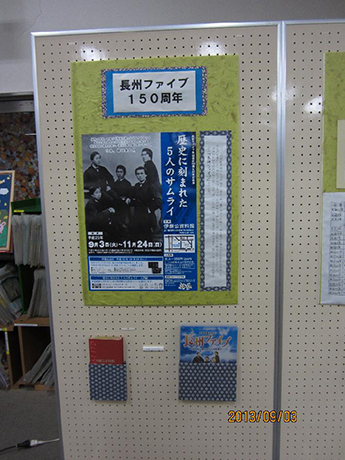
A Choshu Five Exhibition Poster
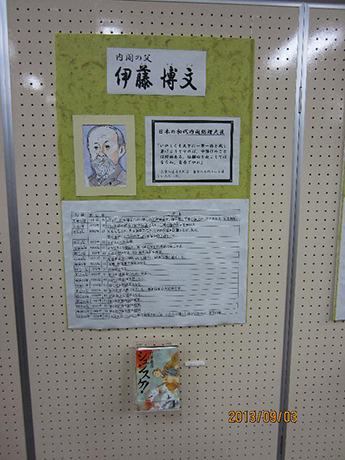
An Exhibition Scene: Introduction of Prince Ito
In the process of selecting documents for this exhibition, we searched for Ito Hirobumi on JACAR's website and consulted with JACAR staff members. We decided upon the following seven items:
(1) Independent Documents: Railways in Tokyo;
(2) Monograph: Documents for Ambassador - Original Book of Compendium of Ambassadors;
(3) Use of Temporary Military Expenditure;
(4) Marquis Ito Hirobumi, Prime Minister Relieved of the Principal Office at his Request;
(5) Original Script Signed by the Emperor, 1889, Constitution, February 11, Constitution of Imperial Japan;
(6) Script Signed by the Emperor, Imperial Ordinance No.314, 1909: State funeral for the Late President of the Privy Council, the Junior First Rank of Court, the Grand Order of the Chrysanthemum, Prince Hirobumi Ito;
(7) Completed the Burial of the Late Prince Ito Hirobumi, The President of the Privy Council.
We discussed procedures about document image usage with JACAR staff for our exhibition and learned that the third document listed above required permission from its holder, the National Institute for Defense Studies. As for the other six images held by the National Archives of Japan, we could use them without going through any procedures if we credited them clearly as from JACAR, for which we included "reference codes" along with the name of their original holding institution.
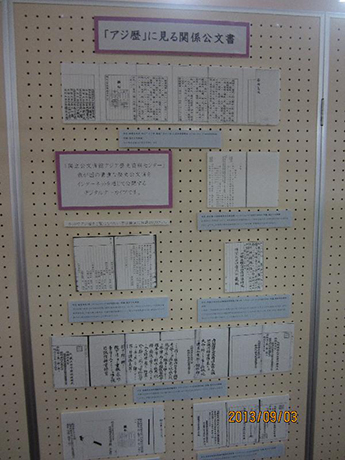
A scene of the exhibition: Display of documents from JACAR
Thanks to assistance from JACAR, we garnered favorable evaluations of our library by those interested in recent and contemporary history—as the exhibit displayed a high level of specialization. Some visitors asked about how to use the JACAR website for searches and we noticed that strong interest meant that JACAR leaflets placed in the exhibit were soon all taken.
At our library we provide reference services on a daily basis. For online services we highly recommend, with confidence and assurance, JACAR's valuable documents to users. We also have added a link to JACAR's homepage on our library's website and we wish to continue to utilize JACAR in many situations.
-EASTICA 11th General Conference & Seminar in Chengdu China (October 14-18)
In 2013 from October 14th to 18th, the State Archives Administration of China and Sichuan Provincial Archives hosted the 11th General Conference & Seminar of the East Asian Regional Branch of the International Council on Archives (EASTICA). This gathering in Chengdu, China was attended by approximately 130 people representing archives of ten member countries and regions. This group had four Japanese participants, notably including President Kato of the National Archives of Japan (NAJ) and a member of Japan Center for Asian Historical Records (JACAR).
On October 16th at the general conference, country and regional reports were delivered. There was a NAJ presentation delivered on digital archival initiatives and archiving of electronic public records in administrative organs.
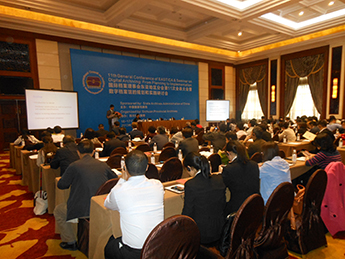
JACAR's Presentation
On October 17th a seminar took place and was themed "Digital Archiving: From Planning to Implementation." A JACAR representative delivered a presentation in the seminar titled "Digital Archiving at the Japan Center for Asian Historical Records." The JACAR member discussed activities of the organization, the background of its establishment, documents, specific details on database development, usage of DjVu format for images and documents, document release plans as well as other matters for the future. The JACAR member also spoke about the Great East Japan Earthquake in 2011, when it became apparent that it was necessary to back up data on magnetic tape not only at the main office in Tokyo, but also in a Tsukuba Annex of the National Archives of Japan. The presentation attracted a large, engaged audience and some people were eager to know the reason for adopting the DjVu format and long-term future plans.
Note: EASTICA is the regional branch of the International Council of Archives. It was established in July, 1993. There are five countries and two regions represented in EASTICA, which include Japan, China, South Korea, North Korea, Mongolia, Hong Kong, and Macao. The organization holds a general conference and an executive board meeting every other year.
-International Symposium in Taipei: "The 4th Annual Conference for Japanese Studies: Looking for the Possibility of International Japanese Studies" (November 8 - 9)
On November 8th and 9th, JACAR staff traveled to National Taiwan University to attend the international symposium "The 4th Annual Conference for Japanese Studies: Looking for the possibility of international Japanese studies." Over fifty scholars from Taiwan, Japan, Korea and the United States attended. Participants actively discussed specialized fields including history, literature, and international relations.
At the conference JACAR's director-general Dr. Ken'ichiro Hirano delivered a keynote speech entitled "From Japan to Asia, further to The World Community: based on JACAR's experience." In Hirano's speech he first explained the purpose of JACAR as well as the trajectory of how it came to be established. Hirano also provided an overview of JACAR's documents and the institution's achievements. Lastly, Hirano emphasized JACAR's user-oriented approach by illustrating the system's comprehensiveness, reliability and credibility. Such features are aimed to contribute to the sharing of materials that will further develop the discipline of historical studies. To facilitate this development, Dr. Hirano hopes to strengthen international exchange and coordination with organizations around the world.
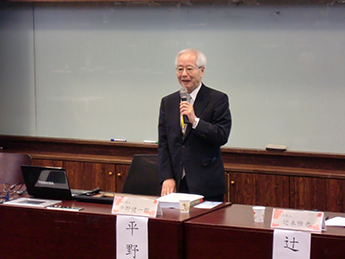
Dr. Hirano's Presentation
At the same time, Dr. Hirano and a JACAR staff visited the Archive of the Institute of Modern History, Academia Sinica Taiwan Historica and National Taiwan University Library, to investigate the condition of historical records related to Japan and exchange opinions about the situation of digitization with staff members of those organizations. Above three organizations are holding Japanese materials mainly created in the time of Japanese domination. They are also digitizing a part of those materials and releasing them on the internet. We will introduce the condition of those materials related to Japan in the section of "Information on Related Document Holdings".
|
November 27
|
Presented at Association of Museums in Fukusima Prefecture General Meeting (Fukushima Prefectural Cultural Property Investigation Center).
|
|
Feburary 3
|
Presented at Netwarok of Museums in Kouchi Prefecture (Kouchi City, Kouchi Prefecture, The Yamauchi hall).
|
|
December 6
|
The Archive of the Institute of Modern History, Academia Sinica, Director and staff
|
|
February 17
|
Okinawa Prefecture Archives, Staff
|
|
February 20
|
The British Library, Staff
|
The Condition of Japan Related Materials in Taiwan
JACAR's Director-general Kenichiro Hirano and a staff member visited three organizations holding materials related to Japan on November 2013. The pair from JACAR conducted interviews about archival digitization and investigated the conditions of materials related to Japan in Taiwan. The conditions of the three organizations visited are outlined below.
・The Archive of the Institute of Modern History, Academia Sinica(→Website)
The Archive of the Institute of Modern History, Academia Sinica has four collections: diplomatic records, economic records, geographical records, and donated materials. Materials related to Japan are included in diplomatic records and economic records.
The diplomatic records consist of the following document series clusters: "Documents created by Ministry of Foreign Affairs of Qing Dynasty" (総理各国事務衙門) (1836-1899), "Documents Created by Department of Foreign Affairs of Qing Dynasty" (外務部) (1900-1912), "Documents Created by the Peking Government's Department of Foreign Affairs" (北洋政府外交部) (1913-1927), and "Documents Created by the Ministry of Foreign Affairs of the Republic of China" (中華民国外交部) (1928-1975). Each series contains diplomatic correspondence between China and Japan as well as documents related to Japan.
Materials related to Japan are also held in the economic materials category and include documents titled, "Wang Zhaoming Government Economic Department" (汪政府経済部門) and "The Delegation of the Republic of China stationed in Japan" (駐日代表団).
Regarding document digitization, over five million pages of diplomatic records have already gone through the process. Online search and browse features for documents are already available from the Qing Government's Ministry of Foreign Affairs, the Department of Foreign Affairs, and the Department of Foreign Affairs. To browse this digital data, online user registration is required. Users sign up on the Archive of the Institute of Modern History, Academia Sinica homepage and sometimes within an hour access is granted.
While all Republic of China Ministry of Foreign Affairs documents were digitized before September 2012, they have not been released on the internet. However, it is possible to search and browse the documents at the reading room of the Archive of the Institute of Modern History, Academia Sinica
Currently, being digitized is "The Delegation of the Republic of China stationed in Japan" (駐日代表団). Those documents will be released on the internet as soon as digitization finishes.
・Taiwan Historica(→Website)
Taiwan Historica holds the following five collections related to the Japanese domination of Taiwan: "Documents Related to Taiwan-Governor's General Office" (台湾総督府档案), "Various Official Record Compilations of the Monopoly Bureau" (専売局公文類聚), "Documents related to The Taiwan Industry Promotion Co., Ltd." (台湾拓殖株式会社関係), "Taiwan-Governor's General Office Gazette" (台湾総督府府報), and "Special collection of Monopoly Bureau Gazette" (典蔵専売局局報). The collection "Various Official Record Compilations of the Monopoly Bureau" also includes documents created by other Japanese governmental organizations, such as the Korea-Governor's General Office and the Ministry of Finance.
The archive contains approximately 15,000 books and periodical publications including "Taiwan-Governor's General Office Gazette" (台湾総督府府報) and "Special collection of Monopoly Bureau Gazette" (典蔵専売局局報) created under Japanese rule. It is possible to examine those books and periodical publications in the reading room located on the archive's premises.
As for the digitization of those documents, "Taiwan-Governor's General Office Gazette" (台湾総督府档案) and "Special collection of Monopoly Bureau Gazette" (典蔵専売局局報) have already been finished. In addition approximately 95 percent of "Documents related to Taiwan-Governor's General Office" (台湾総督府档案) and "Various Official Record compilations of Monopoly Bureau" (専売局公文類聚) have been digitized. Although they are currently being scanned in color, monochrome digitization is complete for "Documents related to The Taiwan Industry Promotion Co., Ltd." (台湾拓殖株式会社関係).
All of the catalogue and document images mentioned above can be viewed free online, with the exception of "Documents related to Taiwan-Governor's General Office" (台湾総督府档案) which requires payment.
・National Taiwan University Library(→Website)
National Taiwan University Library holds materials collected by the former Taipei Imperial University as well as publications created by the Taiwan-Governor's General Office, besides, some donated collections that were collected and owned by former Taipei Imperial University faculty members. Materials collected by the former Taipei Imperial University include large number of written/ transcribed/ published materials of Japanese Edo Era, "Materials Related to Ryukyu" (琉球資料), "Statistical Data on Taiwan under Japanese Rule" (日本統治時期統計資料), etc. There are also research materials on Taiwanese cultural anthropology and on botany such as "Ino Kanori's Manuscripts" (伊能嘉矩手稿) and the "Tashiro Library" (田代文庫). The latter was left behind by the botanist Tashiro Yasusada. In addition, the NTUL also has acquired digital collection of "Archives of Judicature Office under Japanese Rule" (日本統治時期司法関係資料) through collaboration project.
The collections that were collected and owned by former Taipei Imperial University faculty members include the following collections: "The Kanaseki Takeo Library" (金関丈夫文庫), "The Kokubu Naoichi Library" (国分直一文庫), and "The Tanaka Library" (田中文庫, collected by the first director of the former Taipei Imperial University Library). These are also archeological and botanical research materials.
As the progress of digitization of these materials, "Ino Kanori's Manuscripts", "Statistical Data of Taiwan under Japanese Rule", and "Archives of Judicature Office under Japanese Rule" are all available for browsing on the Internet although the last of the three requires registration. The "Tashiro Library", though is still under final checkup, has been partially uploaded for browsing.
Books refering to JACAR or documents from its database donated in current year are as follows.
|
Author or Editor
|
Title
|
Publisher
|
Year
|
|
愛知県史編さん委員会・編
|
愛知県史 資料編31 流通・金融・交通 近代8
|
愛知県
|
2013
|
|
大倉幸宏・編
|
昔はよかったと言うけれど
|
新評論
|
2013
|
|
小林茂
|
外邦図―帝国日本のアジア地図
|
中公新書
|
2011
|
|
小林茂・編
|
近代日本の地図作製とアジア太平洋地域―「外邦図」へのアプローチ―
|
大阪大学出版会
|
2009
|
|
東京女学館編纂室・編
|
東京女学館短期大学史 東京女学館創立125周年記念
|
東京女学館
|
2013
|
|
平野健一郎,古田和子他・編
|
国際文化関係史研究
|
東京大学出版会
|
2013
|
|
宋沢亜
|
清日戦争 Sino-Japanese War 1894-1895
|
后浪出版公司
|
2012
|
|
Ion Scumpieru
|
133 De Ani De Relatii Romania Japonia
|
Fundatia Europeana Titulescu
|
2013
|
|
Period
|
Event
|
Note
|
Link
|
|
July 22nd, 2013
to May 8th, 2014 |
Special Exhibition :
"Japan and Spain, History of Exchange Based on Historical Diplomatic Documents" |
In commemoration of 400 years since the dispatch of the Keicho mission, Japan and Spain are holding various exchange programs in 2013 and 2014.
The Special Exhibition "Japan and Spain, History of Exchange Based on Historical Diplomatic Documents" sponsored by the Diplomatic Archives and the Embassy of Spain depicts 400 years of exchange between Japan and Spain.
|
|
[Postscript]
Thank you for reading JACAR's 13th newsletter, and we hope you enjoyed it.
Above we have discussed how JACAR's materials were used in an exhibition at Hikari city Library.
We believe that librarians and museum curators will find the resources helpful and our next newsletter will be sent out early in July.
Since we aim to make the Newsletter an even more useful reference in the future, we would deeply appreciate any comments or feedback on * THIS FORM *.
Please email us if you would be interested in a member of JACAR presenting at your organization about our institution and its resources. We go to schools, research conferences, and a range of other institutions.
Leaflets about JACAR are available in English, Japanese, and Chinese, so if you would like copies, please contact us.
An email about the JACAR Newsletter has been sent to everyone who requested a copy as well as those who have exchanged business cards with JACAR staff members. If you do not wish to receive future e-mails, please let us know.
[Reference] TEL : +81-(0)3-5805-8801 E-MAIL : jacar_enquire@archives.go.jp

![* Click to Enlarge [Image 1] File information Screen](img/013_content01_01_01_e.jpg)
![* Click to Enlarge [Image 2] Search Results Screen](img/013_content01_02_01_e.jpg)
![* Click to Enlarge [Image 3] Title : 2.Outline of Code Name Development<br>Nov 15 1945 Ministry of War of Japan (1st image)](img/013_content01_03_01.jpg)






